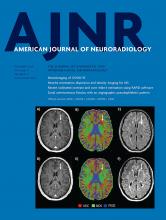Index by author
Seker, F.
- FELLOWS' JOURNAL CLUBNeurointerventionYou have accessTreatment of Ruptured Blister-Like Aneurysms with the FRED Flow Diverter: A Multicenter ExperienceM.A. Möhlenbruch, F. Seker, E. Özlük, O. Kizilkilic, E. Broussalis, M. Killer-Oberpfalzer, C.J. Griessenauer, M. Bendszus and N. KocerAmerican Journal of Neuroradiology December 2020, 41 (12) 2280-2284; DOI: https://doi.org/10.3174/ajnr.A6849
In a retrospective multicenter study, all patients treated with the FRED for a ruptured intracranial blister-like aneurysm between January 2013 and May 2019 were analyzed. In total, 30 patients with 30 ruptured blister-like aneurysms were treated. Immediate complete aneurysm obliteration with the FRED was achieved in 10 patients (33%). Of the 26 patients with follow-up, complete obliteration was achieved in 21 patients (80%) after 6 months and in 24 patients (92%) in the final follow-up (median, 22 months). The authors conclude that treatment of ruptured blister-like aneurysms with the FRED is safe and effective.
Selvi, B.T.
- FELLOWS' JOURNAL CLUBAdult BrainYou have accessClinical and Radiologic Findings of Acute Necrotizing Encephalopathy in Young AdultsH.A. Vanjare, B.T. Selvi, R. Karuppusami, A. Manesh, K. Gunasekaran, A.T. Prabhakar, P. Mannam and A. JasperAmerican Journal of Neuroradiology December 2020, 41 (12) 2250-2254; DOI: https://doi.org/10.3174/ajnr.A6803
The authors describe 10 patients (16 years of age or older) with acute necrotizing encephalopathy. In their study, bilateral thalamic involvement with the trilaminar pattern of diffusion restriction on MR imaging was the predominant finding seen in all of the patients reviewed. Ancillary findings of cerebral white matter, brain stem, and cerebellum involvement with sparing of the basal ganglia were also seen.
Severino, M.
- PediatricsOpen AccessPerinatal Arterial Ischemic Stroke in Fetal Vascular Malperfusion: A Case Series and Literature ReviewA.F. Geraldo, A. Parodi, M. Bertamino, F. Buffelli, S. Uccella, D. Tortora, P. Moretti, L. Ramenghi, E. Fulcheri, A. Rossi and M. SeverinoAmerican Journal of Neuroradiology December 2020, 41 (12) 2377-2383; DOI: https://doi.org/10.3174/ajnr.A6857
- PediatricsOpen AccessNeonatal Developmental Venous Anomalies: Clinicoradiologic Characterization and Follow-UpA.F. Geraldo, S.S. Messina, D. Tortora, A. Parodi, M. Malova, G. Morana, C. Gandolfo, A. D’Amico, E. Herkert, P. Govaert, L.A. Ramenghi, A. Rossi and M. SeverinoAmerican Journal of Neuroradiology December 2020, 41 (12) 2370-2376; DOI: https://doi.org/10.3174/ajnr.A6829
Sganzerla, L.Z.
- NeurointerventionYou have accessSelection of Patients for Treatment of Brain Arteriovenous Malformations by the Transvenous Approach: Relationship with Venous Anatomy and Risk of Hemorrhagic ComplicationsJ.M.B. De Sousa, C. Iosif, L.Z. Sganzerla, A.N. Rafie, V. Borodetsky, A. Rouchaud, S. Saleme and C. MounayerAmerican Journal of Neuroradiology December 2020, 41 (12) 2311-2316; DOI: https://doi.org/10.3174/ajnr.A6810
Shim, W.H.
- Adult BrainOpen AccessDevelopment and Validation of a Deep Learning–Based Automatic Brain Segmentation and Classification Algorithm for Alzheimer Disease Using 3D T1-Weighted Volumetric ImagesC.H. Suh, W.H. Shim, S.J. Kim, J.H. Roh, J.-H. Lee, M.-J. Kim, S. Park, W. Jung, J. Sung, G.-H. Jahng, and for the Alzheimer’s Disease Neuroimaging InitiativeAmerican Journal of Neuroradiology December 2020, 41 (12) 2227-2234; DOI: https://doi.org/10.3174/ajnr.A6848
Shimony, J.S.
- PediatricsOpen AccessLongitudinal Assessment of Neuroradiologic Features in Wolfram SyndromeA. Samara, H.M. Lugar, T. Hershey and J.S. ShimonyAmerican Journal of Neuroradiology December 2020, 41 (12) 2364-2369; DOI: https://doi.org/10.3174/ajnr.A6831
Shotar, E.
- PediatricsYou have accessRisk Factors for Early Brain AVM Rupture: Cohort Study of Pediatric and Adult PatientsL. Garzelli, E. Shotar, T. Blauwblomme, N. Sourour, Q. Alias, S. Stricker, B. Mathon, M. Kossorotoff, F. Gariel, N. Boddaert, F. Brunelle, P. Meyer, O. Naggara, F. Clarençon and G. BoulouisAmerican Journal of Neuroradiology December 2020, 41 (12) 2358-2363; DOI: https://doi.org/10.3174/ajnr.A6824
Simonsen, C.Z.
- NeurointerventionYou have accessPatients Requiring Conversion to General Anesthesia during Endovascular Therapy Have Worse Outcomes: A Post Hoc Analysis of Data from the SAGA CollaborationC.Z. Simonsen, S. Schönenberger, P.L. Hendén, A.J. Yoo, L. Uhlmann, A. Rentzos, J. Bösel, J. Valentin and M. RasmussenAmerican Journal of Neuroradiology December 2020, 41 (12) 2298-2302; DOI: https://doi.org/10.3174/ajnr.A6823
Smith, E.R.
- EDITOR'S CHOICEAdult BrainOpen AccessRecent Administration of Iodinated Contrast Renders Core Infarct Estimation Inaccurate Using RAPID SoftwareA.Z. Copelan, E.R. Smith, G.T. Drocton, K.H. Narsinh, D. Murph, R.S. Khangura, Z.J. Hartley, A.A. Abla, W.P. Dillon, C.F. Dowd, R.T. Higashida, V.V. Halbach, S.W. Hetts, D.L. Cooke, K. Keenan, J. Nelson, D. Mccoy, M. Ciano and M.R. AmansAmerican Journal of Neuroradiology December 2020, 41 (12) 2235-2242; DOI: https://doi.org/10.3174/ajnr.A6908
Patients who received IV iodinated contrast in proximity (<8 hours) to CTA/CTP as part of a separate imaging study had a much higher likelihood of core infarct underestimation with RAPID software compared with contrast-naive patients. Over-reliance on RAPID postprocessing for treatment disposition of patients with extended window emergent large-vessel occlusion should be avoided, particularly in cases with recent IV contrast administration.
So, T.Y.
- Head & NeckYou have accessQuantitative T1ρ MRI of the Head and Neck Discriminates Carcinoma and Benign Hyperplasia in the NasopharynxQ.Y.H. Ai, W. Chen, T.Y. So, W.K.J. Lam, B. Jiang, D.M.C. Poon, S. Qamar, F.K.F. Mo, T. Blu, Q. Chan, B.B.Y. Ma, E.P. Hui, K.C.A. Chan and A.D. KingAmerican Journal of Neuroradiology December 2020, 41 (12) 2339-2344; DOI: https://doi.org/10.3174/ajnr.A6828








